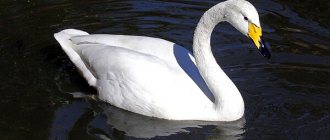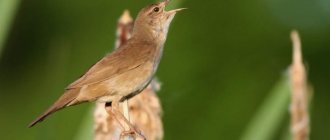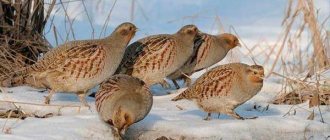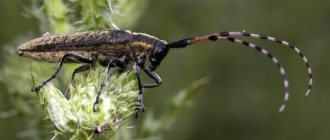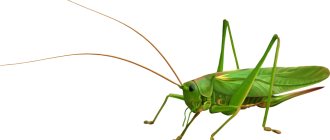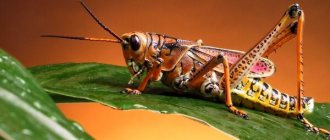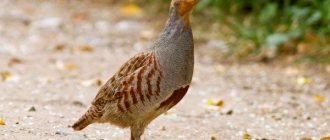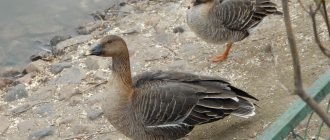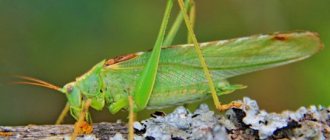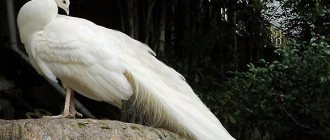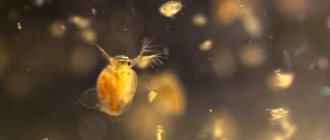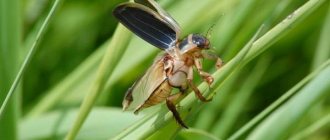Description and features of the mute swan
The mute swan is a bird with a very bright, snow-white outfit: in sunlight it literally blinds. It can rightfully be considered the largest representative of the swan family - the length of an adult bird can be more than one and a half meters, and the wingspan reaches almost two and a half meters! Females are smaller and lighter than males.
It is not difficult to distinguish it from other types of swans; the photo of the mute swan shows that its long neck is curved in an S-shape, its wings are often raised upward, like sails.
The wingspan of a mute swan can reach 2 meters
Another characteristic feature of this bird is that when danger arises and to protect its offspring, the mute swan opens its wings, arches its neck and emits a loud hiss. Although the English translation of its name sounds like “Mute Swan”, this does not entirely reflect reality. In addition to hissing, he can wheeze, whistle and snort.
Listen to the voice of the mute swan
Like some other species of swans, the mute mute has a dark knob-like growth above its beak - and it is larger in males than in females.
This feature appears only in adult sexually mature individuals. The beak is orange-red, the top, along the contour and the tip of the beak are black. The paws along with membranes are also painted black.
Once upon a time, hunting mute swans was a popular sport, which negatively affected the population of these birds. In the middle of the last century it was officially banned.
However, to this day it is a rather rare bird that needs special protection. Pollution of water bodies due to oil and fuel oil leaks greatly harms birds. They die when they fall into oil and fuel oil puddles.
The mute swan is included in the Red Books of some countries and certain regions of Russia. In Europe, swans are often fed, they get used to people and become almost tame.
Keeping at home
Of course, many bird lovers are seriously wondering about the possibility of keeping swans on estates. Is this real? It turns out yes. But creating the right conditions can be very difficult.
Creating optimal conditions
First of all, birds need to be given the opportunity to spend a lot of time in the water. Moreover, this should not be a basin or a bathtub, but at least a small pond - at least 6-8 square meters per couple with a depth of 1 meter or more. Or better yet, a more spacious one so that the birds can gracefully glide across the surface, dive and get suitable food.
Attention! They must swim both in summer and winter - perhaps with the exception of the frostiest days, when the temperature drops to -25 degrees and below.
You also need to think about a suitable house. In fact, it is only needed for bad weather - for example, on rainy and windy days. And of course, for the winter, to protect the birds from frost.
There should be at least one and a half square meters per bird, and a height of 2 meters or more. Don’t forget about good thermal insulation and heating - it is advisable that in winter the temperature in the swans’ house should be at least +20 degrees - then they will suffer less often from colds.
Nesting, chicks
The breeding season for mute muzzles in captivity begins around mid-to-late March, the specific date depending on the climate and weather in the area.
For reproduction you need to create suitable conditions.
For reference! In the wild, only a few birds live to be 20 years old, and the centenarians live to be 25. When kept in captivity, most swans live to be at least 30 years old.
First of all, this is a nest. The easiest way is to install a fairly large box near a pond and fill it with straw. But some bird lovers even build small houses to protect the birds from the weather. Suitable building materials can be placed around - then the swans will be able to equip the nest as they see fit.
The female incubates the eggs
After laying eggs, the female takes care of them and incubates them for more than a month. All this time, there should be a feeder nearby so that she can eat normally without leaving the nest for a long time.
Swans take care of their chicks themselves - they are simply exemplary parents. The owner only needs to provide the birds with suitable food, protect them from external threats and not interfere with the rearing process.
Diet
Of course, it is simply impossible to recreate at home exactly the same diet as in the wild. But getting close to him is fine.
The diet must include:
- boiled fish,
- meat,
- vegetables (beets, cabbage, pumpkin, carrots),
- cereals (millet, barley),
- greens (nettle, dandelions, dill, green onions).
It is very important to monitor how much feed the birds receive. They should eat all the food they receive in about 15-20 minutes (20-30 in winter), and they need to be fed twice a day - at about the same time.
Important! Overfeeding often has a worse effect on the bird's body than underfeeding.
You also need to carefully monitor the condition of the swans. If they lose weight or, on the contrary, gain excess weight, the portion size needs to be changed.
Interesting facts about the mute swan
— In order for this bird to take off, it needs a sufficiently large space to run. They cannot take off from land.
— There are legends about swan fidelity: if the female dies, the male flies to a great height, falls down like a stone and is broken. However, this is not entirely true: swans really form stable families that last throughout their lives - they do not change partners. But still, if one of the couple dies, the second partner creates a new family; they do not live alone.
— In Great Britain, the swan has a special status: the entire population of these birds belongs personally to the Queen and is under her special protection. In Denmark it is recognized as the national bird and is one of its symbols.
Story
Swans got their name “mute” because of their hissing in moments of danger.
These birds belong to the “Eurasian” species. Initially, they lived in Central and Northern Europe, England and the territory from Asia Minor to China. Since the end of the 19th century, mute swans began to be imported to America, Africa and Australia.
Since 1984, mute birds have been considered the national bird of Denmark.
Since the 15th century, only people with high social status could have mute dogs in England. Swans were ringed, which meant they had an owner. Now in England, hissing swans belong to the royal family.
Until the mid-20th century in Belarus and Lithuania, the number of these birds tended to zero. Only a ban on hunting helped restore the population. Now the total number of mute mutes on earth is 500-600 thousand individuals.
Lifestyle and habitat of the mute swan
The mute swan lives in the waters of central Europe, Great Britain, some countries of Northern Europe, the Baltic, and is also found in Asian countries.
In Russia, it nests in small numbers almost everywhere, including certain regions of the northern part of the country - Leningrad, Pskov regions, as well as the Far East.
For the winter, mute swans fly to the Black, Caspian, Mediterranean Sea, and lakes of Central Asia. However, at the first thawed patches, it hurries to return to its usual habitat. They migrate and winter, uniting in flocks. During flight, you can hear whistling sounds made by the wings.
The mute swan spends most of its life on the water, only occasionally venturing onto land. At night it hides in thickets of reeds or aquatic plants. They often live in pairs, at a great distance from each other. Less often they can be found in a group.
The mute swan is a rather aggressive bird, sensitively protecting its territory from other birds. It has strong wings and a powerful beak, which it uses for defense - there are known cases when a swan caused serious injuries even to humans.
Reproduction
By the age of four, swans form a pair and remain faithful to their partner for the rest of their lives. The breeding season begins in mid-March. Mating dances begin with a smooth circle around the female. The male spreads his wings, arches his neck, and fluffs up his plumage. The female accepts courtship and joins in the dance, which usually ends with mating.
The pair builds a nest in reed thickets and shallow waters. Usually only the female participates in the construction of the nest - the male protects the territory from possible invasion by other pairs or single males. The average diameter of a bird's nest is more than two meters. For construction, moss and cattails, dry grass and plant branches, and fluff are used. Most often, the same nest is used for many years.
The average clutch consists of six eggs. In good years, when there is enough food, the female can lay eleven eggs, which she incubates for 35 days.
The chicks are covered with very warm and thick down of a brownish or dirty gray color. From the first hours of life, they are excellent at swimming and diving, and are able to obtain food themselves. Therefore, after drying, they leave the nest with their parents. The couple and their brood spend all the time on the water. The babies warm up and dry out after long swims on the backs and under the wings of their parents. The young begin to fly only at the age of three to four months.
The description of the appearance of the young differs not only in the color of the down, but also in the color of the beak. All young birds are distinguished by a pink beak with a black droplet at the tip. In flight, the young look more like a greylag goose than a swan. Young birds change into adult feathers only at the age of three.
Mute swan feeding
They eat mainly underwater parts of plants, algae and young shoots, as well as small crustaceans and mollusks. To obtain food, they often lower their head deeply under water, capsizing to a vertical position. On land it almost does not feed, only in case of bad weather conditions - storm or flood.
You should never feed a swan bread - this is detrimental to its health and even life. It is best to give a mixture of grain crops and juicy vegetables - pieces of cabbage and carrots - as complementary foods.
Gallery
- A mute swan guarding its swans (not pictured)
- Finding food underwater
- Mute swan in flight
- Flock in flight
- Landing on water
- Mute swan egg
- Finnish stamp from 1956 depicting a mute swan
- Head profile, Windermere, England
- Four mute swans on the banks of Etobicoke Creek
- A family of mute swans on a small lake in Southern Michigan, USA
- Mute swans in Koutavos Lagoon, Kefalonia, Greece.
- Thorn swans on Lake Orongoy, Buryatia
- Thorn swans in a field near the Vistula River in southern Poland
- Mute swan and swans on a duckweed indoor pond in New York
Evolution
Fossils of a mute swan, 6,000 years old, were discovered in post-glacial peat beds in eastern England, UK.[9] They have been recorded from the east of Ireland to Portugal and Italy.[10] and from France 13,000 (Debrosse and Murer-Chauvir 1972–1973).[ full citation required
] The paleosubspecies Cygnus olor bergmanni
, which differed from a living bird only in size, is known from fossils found in Azerbaijan.[
citation needed
]
Fossils of ancestral swans more distantly related to the mute swan have been found in four US states: California, Arizona, Idaho and Oregon.[11] The chronology begins from the Miocene to the end of the Pleistocene, or 10,000 years ago. The latest discovery was made in the Anza Borrego Desert, a state park in California.[11] Fossils from the Pleistocene include Cygnus paloregonus
from Fossil Lake, Oregon, Fromans Ferry, Idaho and Arizona, which Howard talks about in Waterfowl of the World
as "probably a mute-type swan".[12]
Breed overview
Such a rare representative of the feathered kingdom as the mute swan has chosen the north of Europe and Asia. But the man helped him settle down in Australia, America and Africa, receiving in return a landscape decorated with birds and beautiful photos of a swan. The average lifespan of this bird is 28 years. She leads a sedentary lifestyle and rarely flies from place to place. Despite the fact that the male chooses a mate once in his life, he can also get along with another female.
In what situations is this possible? This is normal practice if the female dies. The new couple will live where the oldest partner has settled. If a winch loses her feathered lover, she can also quickly find a younger replacement.
The proud, handsome bird, which reacts to strangers and people by hissing, is the heaviest flying bird. A male can weigh 14 kg. The record weight of a male of this representative of ducks is 25 kg. He was raised and shown to the whole world in Poland, but no one can say for sure whether this plump male could fly or not.
Origin
This hissing bird is Eurasian. It became widespread twice: at the end of the 19th century and in the 1930s, when the swan was brought to Victoria. There, a unique swan decorated the parks, and is now carefully protected by the city authorities.
Appearance
The mute swan has a long neck, an oblong body and a medium-sized head. At the base of its beak you can see a black growth (frenulum), although the beak has an orange-red color. The growth tends to swell during the mating season. During this period, this part of the beak becomes more noticeable. If you see a handsome white male with a swollen frenulum, be sure that this is a male.
The maximum length of its body is 180 cm. Males can be quite plump, and females are significantly inferior to them in size (only 5-6 kg). The wingspan of this specimen is 240 cm.
Peculiarities
The mute swan got its name because of the sound it makes when irritated. The English name of this bird is “mute swan”, so it is believed that it is only capable of hissing. But the hissing swan can also make sounds that are similar to grunting, whistling and snorting.
Its lifestyle copies the behavior of such a bird as the whooper. This means that the swan likes overgrown ponds and swamps. The trademark of the hissing beauty is a neck in the shape of the Latin letter “S” and slightly raised wings. In addition, the feathered representative can flap its wings very loudly. By the way, this is a unique feature of the bird. The sound that the wings make in flight can be heard at a distance of 1 km.
Nutrition
The mute swan has its own diet, which consists of aquatic plants and small aquatic animals. He sometimes likes to feast on shellfish and aquatic burros. During molting, an adult can eat approximately 4 kg of various aquatic plants (if it is on land, then also cereals). In captivity (zoo), children and adults try to feed the bird bread, but this is prohibited. A mute swan can get sick and die from eating flour products.
Offspring
The proud mute swan adheres to monogamous relationships and finds one mate for life. Birds begin to nest when they are 3-4 years old. Swans mate on the water and then begin laying eggs. The period when eggs are laid falls in March. At this time, males become very aggressive. This is exactly the case when you can clearly hear the hissing of a bird.
A swan's clutch can contain from 5 to 8 eggs. Young females that lay eggs for the first time may only lay one egg. The shell color of swan products is yellow-brown. The female incubates the eggs for a little over a month. The weight of hatched chicks is 220 grams. The mute swan takes care of such babies for up to 5 months.
Feeding birds in winter
Healthy wild birds accumulate fat reserves for the winter, which help them survive the meager winter diet. But in a harsh winter (frost below 15 °C) or a bird that is weakened, perhaps by illness or injury, needs to be fed, otherwise it will die. For these purposes, feeders are installed on the ice of frozen reservoirs or on the shore.
Number
The total population worldwide is about 500 thousand individuals, with 350 thousand living in Russia. A very large population is concentrated in the Volga delta. About 30 thousand individuals live in the UK. And in other countries there are much fewer mute swans.
In the 1980s, lead poisoning caused serious damage to the population. Lead was used as fishing weights, but over time, less toxic analogues appeared, and therefore the population began to grow rapidly. But in some countries, for example, in Belarus, mute swans are listed in the Red Book.
If you find an error, please select a piece of text and press Ctrl+Enter.
What do they eat
The basis of the diet of mute swans is plant food. Birds are in search of food throughout the day - a large adult can eat up to 4 kg of food per day.
Thanks to their long flexible necks, birds can obtain vegetation from the bottom in shallow water that other birds cannot reach. When diving, they dive to a depth of 1 m, while only the tail and legs can be seen from the water. Mute mules can stay under water for up to 10 seconds, during which time they eat. On land, birds consume grasses, cereals, and fodder crops. Among animal foods, they are not averse to eating toads, small fish, insects, and mollusks.
Important! Swans (as well as other waterfowl) should never be fed any baked goods! Such food can lead to the death of birds. If you want to help mute birds survive the winter, feed them with a grain mixture.
